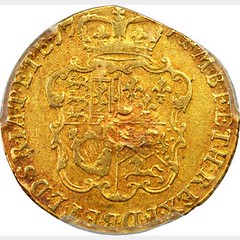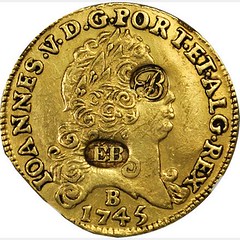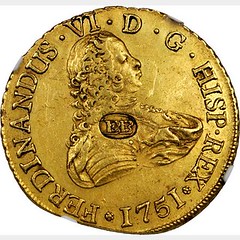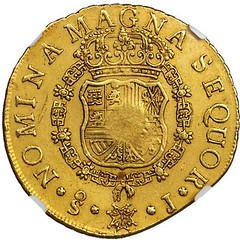
PREV ARTICLE
NEXT ARTICLE
FULL ISSUE
PREV FULL ISSUE
REGULATED GOLD: STACKS'S BOWERS MAY 25, 2016 SALE
While this week's Stack's Bowers Pogue sale will be likely set price records and draw wide attention to high-grade U.S. coins,
there are other rarities coming to the block worth mentioning. The firm's upcoming May 25, 2016 Rarities sale features an amazing
selection of colonial-era regulated gold coins, many of which bear the mark of goldsmith Ephraim Brasher of Brasher Doubloon fame. Here
are some selected lots. -Editor
Lot 3: Ephraim Brasher regulated English 1774 guinea
 
(ca. 1784) Ephraim Brasher regulated English 1774 guinea ($4 2/3). AU-50 (PCGS). Countermarked once, single diagonal clip. No plug. The oval EB mark is identical to all those offered herein, the same mark seen on the famous Lima and New York style Brasher doubloons. Brasher applied his mark as close to center as possible; when he followed John Burger, who tended to place his mark on a portrait's eye, the Brasher mark tends to be nearer the base of the bust. Brasher marks are often seen lightly doubled. On this specimen, the mark was first applied with the punch face not perfectly parallel to the host, leaving just the upper right corner of the errant first impression above B. The dominant impression was placed heavily and neatly, offering a superb and intact strike of the most famous touchmark in American numismatics. Brasher seems to have accomplished a lot more reduction of full-weight coins than plugging of underweight specimens. His clips tended to be straight across the lower right or lower left of specimens he regulated, thus making the clipping obvious rather than the well-hidden circumferential clipping of those with criminal intent. The 1784 New York standard that Brasher worked under required an acceptable guinea to weigh 5 pennyweight, 6 grains, equal to 126 grains or about 8.16 grams. The weight of this coin was not measured by PCGS and is thus not available at the time of cataloguing. Several other Brasher guineas are known. Another bearing the date 1774, like this specimen, realized $43,700 in the Eliasberg world gold sale over a decade ago. Three other Brasher guineas were included in the Garrett collection, all sold in the 1981 Garrett IV auction. The only one of this George III type had its date clipped away; the other two were a 1734 with the young bust of George II and a 1749 showing George II's older portrait. The 1749 George II guinea from Garrett, marked by both Brasher and Burger, re-appeared in the 2010 Roehrs sale, selling for $46,000. To read the complete lot description, see:
Lot 5: Ephraim Brasher and John Burger regulated Brazilian 1745 Bahia 6400 reis
 
(ca. 1784) Ephraim Brasher and John Burger regulated Brazilian 1745 Bahia 6400 reis or half Joe ($8). 13.928 grams. AU-50 (NGC). Countermarked twice, single diagonal clip. No plug. A superb early half Joe, struck in the Brazilian city of Bahia in 1745 and already four decades old by the time it reached the liberated post-Revolutionary city of New York. The large round mark of John Burger is ideally struck and perfectly situated at its typical location, on the eye of the portrait, while the classic oval mark of Ephraim Brasher is equally boldly struck lower on the portrait. No plug is seen beneath either mark, suggesting than this coin remained essentially unclipped between 1745 and 1784. Burger took just a light diagonal clip, affecting just a handful of denticles, from the usual location in the lower left. The half Joes (sometimes called a Joe, or Johannes, or half Johannes) of Portugal and Brazil played an outsized role in American and British commerce during the second half of the 18th century. This is the denomination most commonly encountered regulated by American goldsmiths, and this is the gold coin most often described in the documents and newspapers of 18th century North America. While Spanish 8 escudos still maintain a dominant position in the popular imagination, after 1750 their primacy was usurped by the coins struck by Portugal at mints in Lisbon, Rio, and Bahia. Mints producing half Joes also existed in other locations, including Baltimore. Half Joes were so dominant in the West Indian trade that producing lightweight counterfeits exclusively for that market became a popular and profitable enterprise. Just as North American regulators plugged and marked coins to mark them as acceptable, individual islands of the Caribbean also assessed and countermarked half Joes in the era from 1790 to 1820. John Burger marks on half Joes are known to share space with the marks of Martinique, Guadeloupe, and perhaps other islands. To read the complete lot description, see:
Lot 7: Ephraim Brasher regulated Chilean 1751 Santiago 8 escudos
 
(ca. 1784) Ephraim Brasher regulated Chilean 1751 Santiago 8 escudos ($15). 26.358 grams. AU-53 (NGC). Countermarked once, single diagonal clip. No plug. As surely as the gold pieces coined by Ephraim Brasher in 1786 and 1787 are Brasher doubloons, so too is this piece, an 8 escudos or doubloon marked by Brasher before he coined what are today multimillion dollar rarities. As interesting as the connection to Brasher's doubloons is, this coin may have a still more interesting tale to tell. Collectors of Latin American gold will recognize the 1751-J 8 escudos issue of the Santiago Mint for its connection to the 1752 wreck of the Nuestra Senora de la Luz. Among the portion of that wreck's riches that were salvaged in the early 1990s, some 74 specimens were recovered from these precise dies, called I/5 or the "high bust" in the 1993 Sotheby's sale of "the Uruguayan Treasure of the River Plate." The portion of the wreck found and sold in modern times was just a small fraction of the coins lost, however, and the introduction to the Rio de la Plata catalog estimates that 90% of the gold coins sent into the water near Montevideo were recovered within a few years of the ship's loss. This coin may be one of them. It retains a good deal of lustre and some areas of prooflike reflectivity even as areas of the fields, particularly on the reverse, show some scattered faint abrasions that give this coin a seawater appearance. Unlike most of the coins recovered from La Luz, this coin shows actual wear on the devices, in addition to its famous countermark. The Brasher mark, produced by the same punch that stamped Brasher's more famous doubloons, is deeply sunk at the center, noticeably doubled but still crisp and very clearly attributable as the punch by which Brasher gained his numismatic fame. To read the complete lot description, see:
Lot 8: Ephraim Brasher regulated Brazilian 1726 Minas Gerais 20,000 reis
 
(ca. 1784) Ephraim Brasher regulated Brazilian 1726 Minas Gerais 20,000 reis ($30). 52.4 grams. XF-45 (NGC). Countermarked once, no clip. No plug. Formerly mounted at 12:00. A remarkable new discovery and perhaps the most impressive of all Ephraim Brasher regulated coins known, this specimen's title as the largest Brasher regulated gold coin will never be taken from it, as no larger gold coin ever circulated in the American colonies and early United States. The 1842 Manual of Gold and Silver Coins of All Nations by Jacob Eckfeldt and William DuBois of the United States Mint called this denomination "the heaviest coin of modern times" noting that "the five-moidore piece of Portugal [was] struck about a century ago, weighing 828 grains and worth $32.70." In 1846, William DuBois published Pledges of History: A Brief Account of the Collection of Coins Belonging to the United States Mint, where he called this denomination "the largest of gold coins." In 1784, a five moidore such as this was worth $30, nearly twice as large as the Double Joe of 12,800 reis and exactly twice as valuable as a Spanish 8 escudos. The 20,000 reis denomination was coined from only 1724 to 1727, exclusively at the mint in the Brazilian gold-mining district of Minas Gerais. The 4000 reis or moidore, which was coined throughout the 18th century, was so common that its name -- moidore -- literally means "gold coin," from the Portuguese moeda d'ouro. Its value in Federal money was $6, making this coin worth an even $30. To read the complete lot description, see:
Lot 9: Joseph Richardson regulated Brazilian 1752 Rio 6400 reis
 
(before 1777) Joseph Richardson regulated Brazilian 1752 Rio 6400 reis or half Joe. 13.968 grams. AU-55 (NGC). Countermarked and plugged once. This important early American gold coin was regulated by Joseph Richardson the Elder, one of the colonies' most important gold and silversmiths before his retirement in 1777. The edges were carefully clipped circumferentially by parties unknown who were enriched by the theft. The delicate diagonal reeding that was placed on the rim after the clipping sought to replace the twin-leaf decoration that was present when this coin was struck, perhaps fooling casual observers but leaving the clipping and cover-up perfectly obvious to advanced observers then and now. To replace the gold missing from the edge, Richardson placed a substantial plug at the center, flat and taut at the central obverse, more bulbous on the reverse where the gold pin was carefully peened down after being slid through a small hole from the obverse. The plug is oval in form on the obverse, round on the reverse. The Richardson mark, IR in a square with no dot between the letters, is familiar from many of his silver works and distinctive from the JR mark of his son, Joseph Richardson the Younger. The only Richardson regulated coin known to Gordon was the 1730 double Joe (12,800 reis) in the Roehrs Collection. The mark used on that coin is identical to the mark seen here, and both match the 1746 4 escudos of Bogota housed in the Lasser Collection at Colonial Williamsburg. Neither of the other recorded specimens is as well preserved or as physically attractive as this specimen. To read the complete lot description, see:
To read an earlier E-Sylum article, see:

Wayne Homren, Editor The Numismatic Bibliomania Society is a non-profit organization promoting numismatic literature. See our web site at coinbooks.org. To submit items for publication in The E-Sylum, write to the Editor at this address: whomren@gmail.com To subscribe go to: https://my.binhost.com/lists/listinfo/esylum All Rights Reserved. NBS Home Page Contact the NBS webmaster 
|